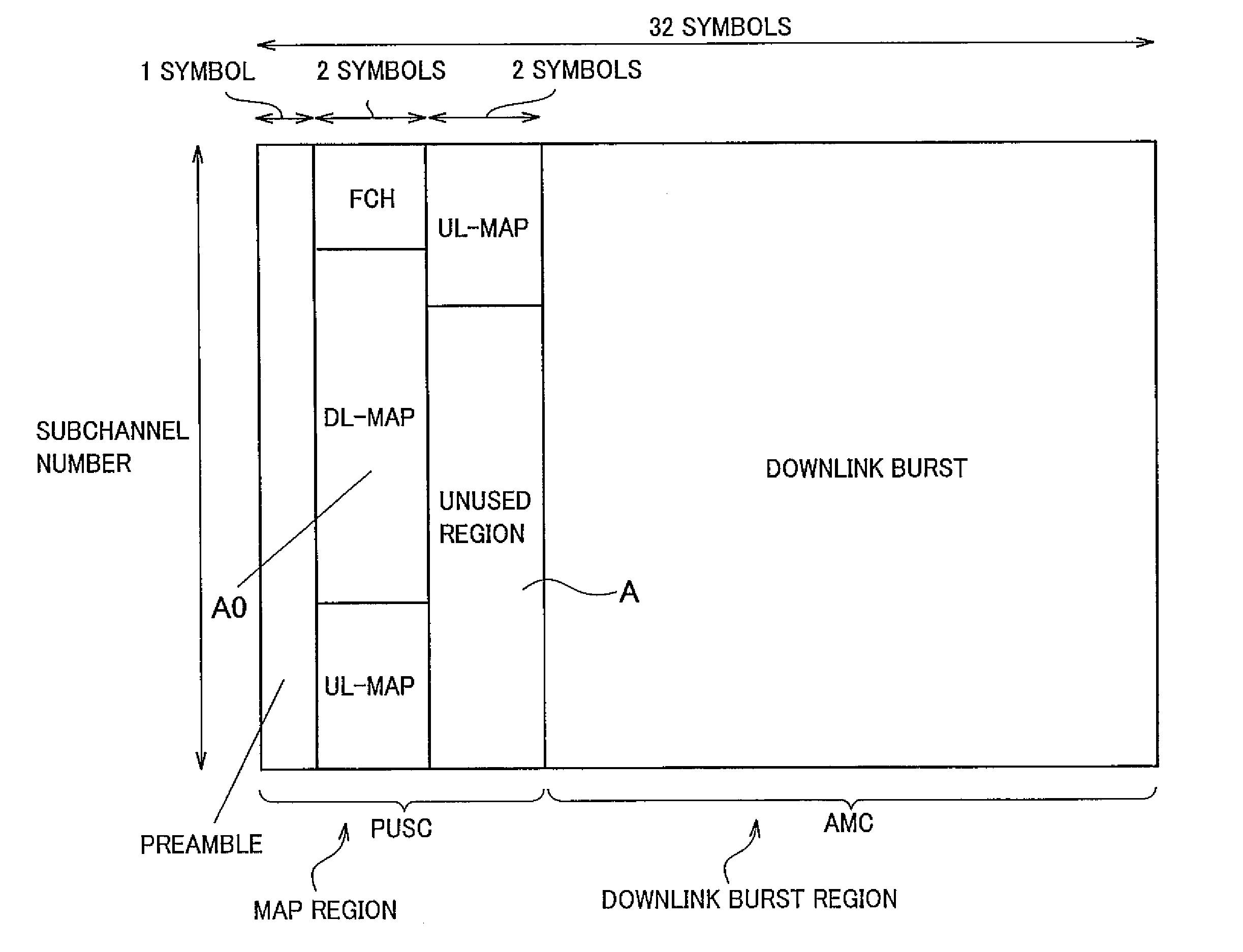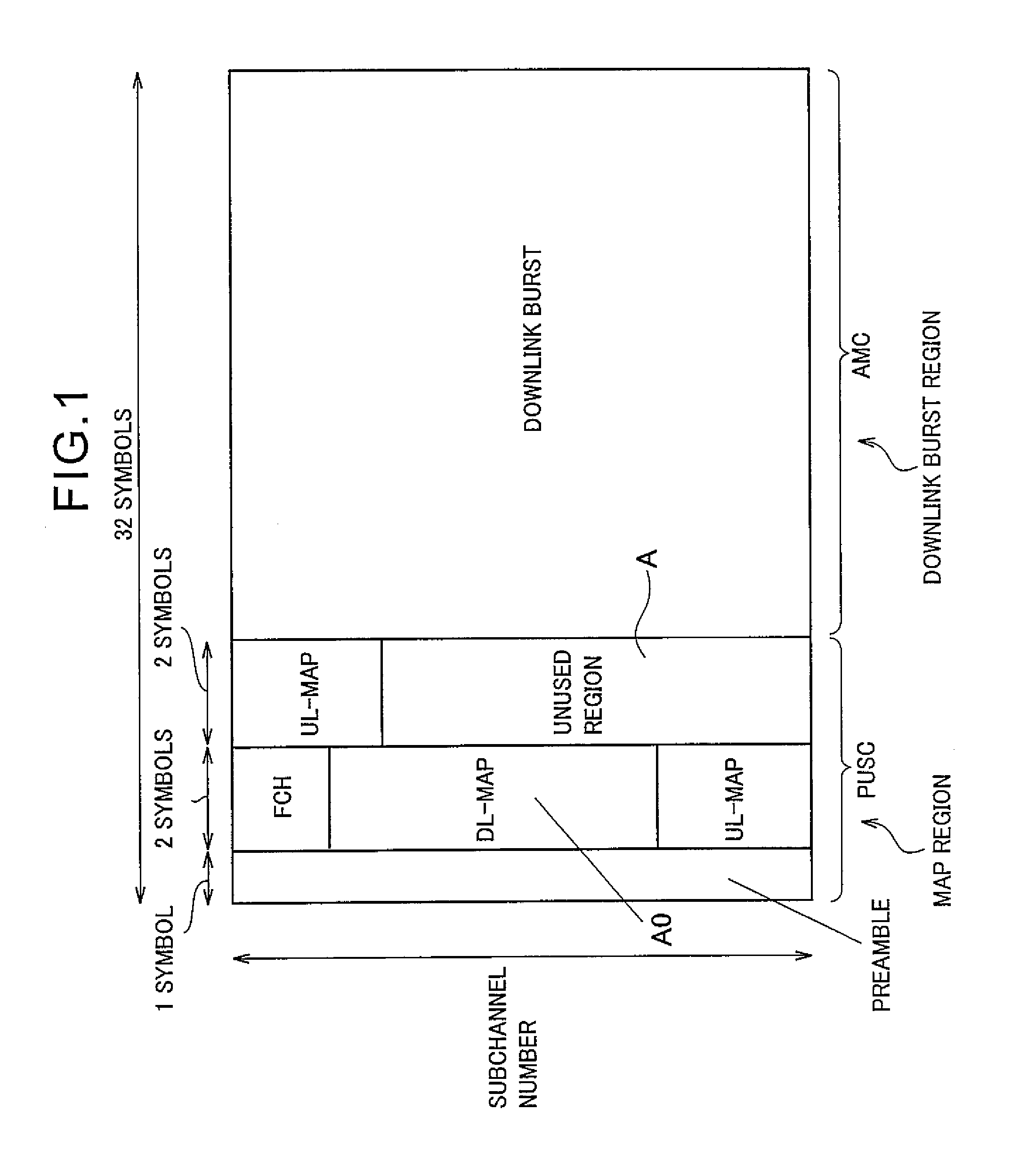Base Station, Mobile Station and Mobile Communication Method
a mobile station and base station technology, applied in the field of base station, mobile station and mobile communication method, can solve the problems of deteriorating transmission speed of downlink burst, higher reception processing of dl-map by wimax compatible mobile station ss, etc., and achieve the effect of increasing the proportion of dl-map in the frame structure and improving the reception probability of dl-map
- Summary
- Abstract
- Description
- Claims
- Application Information
AI Technical Summary
Benefits of technology
Problems solved by technology
Method used
Image
Examples
first embodiment
Configuration of a Mobile Communication System According to the Present Invention
[0045] A configuration of a mobile communication system according to a first embodiment of the present invention will be described with reference to FIG. 4 to FIG. 12. As shown in FIG. 4, a mobile communication system of this embodiment includes a WiMAX compatible mobile state SS and a WiMAX compatible base station BS.
[0046] Specifically, as shown in FIG. 4, the WiMAX compatible base station BS is configured to transmit transmission information in a downlink burst region (such as a downlink burst), to each WiMAX compatible mobile station SS with a directional beam by use of an AAS.
[0047] Moreover, the WiMAX compatible base station BS is configured to transmit transmission information in a MAP region (much as DL-MAP), to all the WiMAX compatible mobile stations SS located in the area managed by the WiMAX compatible base station BS with a non-directional beam instead of using the AAS.
[0048] The WiMAX c...
second embodiment
OF THE PRESENT INVENTION
[0121] A second embodiment of the present invention will be described with reference to FIG. 15 to FIG. 18. The following description will mainly focus on differences of the second embodiment of the present invention from the first embodiment.
[0122] As shown in FIG. 2, a MAP region allocator unit 10B of a WiMAX compatible base station BS of this embodiment is configured to detect an unused region B that is a region where no transmission information (the preamble, the FCH, the DL-MAP, and the UL-MAP) is allocated in a MAP region after allocating the transmission information to the MAP region, and to detect an unused region C that is a region where no transmission information (downlink bursts addressed to a plurality of WiMAX compatible mobile stations SS) is allocated in a downlink burst region after allocating the transmission information to the downlink burst region.
[0123] In this case, as shown in FIG. 15, the MAP region allocator unit 100 is configured t...
third embodiment
OF THE PRESENT INVENTION
[0154] A third embodiment of the present invention will be described with reference to FIG. 19 to FIG. 22. The following description will mainly focus on differences of the third embodiment of the present invention from the first embodiment and the second embodiment.
[0155] As shown in FIG. 3, a MAP region allocator unit 10B of a WiMAX compatible base station BS of this embodiment is configured to detect an unused region B that is a region where no transmission information (the preamble, the FCH, the DL-MAP, and the UL-MAP) is allocated in a MAP region after allocating the transmission information to the MAP region.
[0156] And, the MAP region allocator unit 10B is configured to detect an unused region E that is a region where no transmission information (downlink bursts addressed to a plurality of WiMAX compatible mobile stations SS) is allocated in a downlink burst region after allocating the transmission information to the downlink burst region.
[0157] Here...
PUM
 Login to View More
Login to View More Abstract
Description
Claims
Application Information
 Login to View More
Login to View More - R&D
- Intellectual Property
- Life Sciences
- Materials
- Tech Scout
- Unparalleled Data Quality
- Higher Quality Content
- 60% Fewer Hallucinations
Browse by: Latest US Patents, China's latest patents, Technical Efficacy Thesaurus, Application Domain, Technology Topic, Popular Technical Reports.
© 2025 PatSnap. All rights reserved.Legal|Privacy policy|Modern Slavery Act Transparency Statement|Sitemap|About US| Contact US: help@patsnap.com



